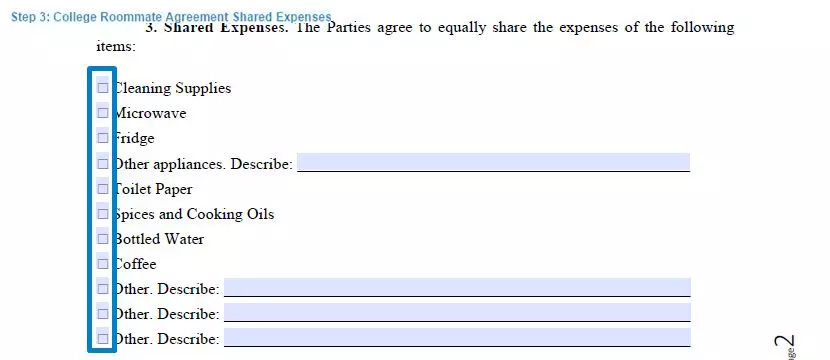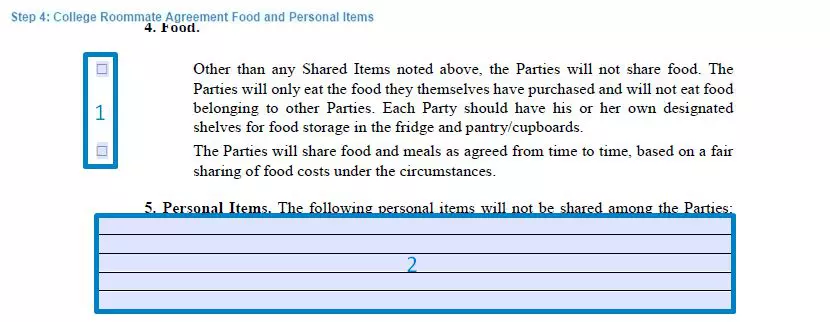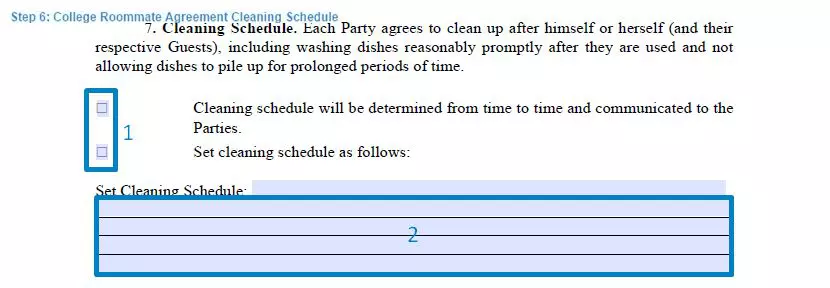College Roommate Agreement Template
College roommate agreements are a great idea for keeping roommate situations equitable and friendly. Setting out a rental agreement at the start, including ways to change the agreement, and update things from time to time is a great way to make sure that your college experience starts on the right foot.
Here’s how you make a great college roommate agreement and everything that should be included in case your college didn’t provide a good room rental agreement template for you to start with.
Build Your Document
Answer a few simple questions to make your document in minutes
Save and Print
Save progress and finish on any device, download and print anytime
Sign and Use
Your valid, lawyer-approved document is ready
Why Use the Agreement?
Agreements might not seem that important if you’re going to be living with friends, but living together is a lot different than just hanging out or staying over from time to time. Since you’re probably all figuring out how to live on your own, it’s even more important than normal to make sure that you have a good roommate agreement.
Having an agreement will help you work out how to live together, settle disputes, and still stay friends.
If you’re moving in with people you don’t know as well, a solid agreement is even more important. That way, you know exactly what the expectations are and can avoid any major problems or fighting.
What Should Be Included in the Agreement?
Every agreement is different. The short answer is that you should include any information about how the house should be kept along with any other details that will help you stay focused on your studies. Common details include:
- Bedtimes (or when everyone should leave common areas)
- Quiet hours
- Cleaning schedules
- What is and isn’t shared
- Food arrangements
- Storage space
- How to manage disagreements
Of course, not every roommate agreement needs all of those details and some roommate agreements will need more sections to cover things a little more thoroughly. You should talk with your future roommates and see what things are most important to them and come up with a list of important decisions and compromises.
Making Changes to the Agreement
Your first dorm roommate agreement might not be your last one. Since college is when people are figuring out living on their own and establishing new habits, you may realize that you need to update your agreement from time to time to keep everything working well.
It’s important in the beginning to set up a process for changing, or at least considering changes, to your original agreement. That might look like monthly roommate meetings to talk about how things are going and discuss changes, or it might be a way to ask for changes to be made in person or a group chat.
It’s important not to change the agreement too often since you’ll have no way to know if your new arrangement is working if you don’t give it a chance. But you also shouldn’t feel locked into an agreement that is permanent and unchangeable.
College Roommate Agreement Form Details
| Document Name | College Roommate Agreement Form |
| Other Name | Dorm Roommate Agreement |
| Avg. Time to Fill Out | 15 minutes |
| # of Fillable Fields | 99 |
| Available Formats | Adobe PDF |
| College Roommate Guide | |

Filling Out a College Roommate Agreement
It’s a good idea to start with a college roommate agreement template like the free one we provide, but it’s also important to customize your agreement as you go through it. Don’t be afraid to change sections of your agreement as you make it and make sure to include how the agreement can be changed in the future.
Don’t let yourself get locked into a strict agreement that may not work later like Leonard and Sheldon on the Big Bang Theory!
Step 1: Personal Information and Contact Information
The first thing you need to do is to fill out everyone’s personal information. Since this is an informal agreement between roommates it’s okay to use nicknames instead of your legal name, just make sure you’re using a name you don’t mind your roommates knowing and using.
In addition to signing that you’re agreeing to be a roommate with your other roommates, you should also include everyone’s preferred contact information and at least one emergency contact. Since you’re all living together, you’ll need to know who to contact in case of an emergency.
This information should always be current, so make sure you agree to update everything if contact people, phone numbers, and other contact information changes.

Step 2: Quiet Hours
At least some of your time as a college student should be spent focused on your studies and taking care of yourself, but that can be hard if your roommates are up until all hours talking with friends on the phone or throwing crazy parties in the backyard.
Agreeing to quiet hours ahead of time is an important step to make sure you have time to study and sleep. You can also include a way to plan late parties and what sounds are allowed or not. For instance, it might be okay to run your dishwasher during quiet hours, but not the TV.

Step 3: Shared Expenses
Most roommates end up sharing at least some expenses like the costs of paper towels and other conveniences. Unless you want to keep all of your spending completely separate, it’s important to designate exactly what is and is not shared. That way, you don’t end up spending more than you can afford, expecting to get paid back or get asked to help pay for things you never wanted or needed.
This way, you can cover who will pay for what, what is shared, and whether big items like furniture or appliances are a shared expense.

Step 4: Food and Personal Items
Food might be something you want to share or partially share or something everyone is responsible for on their own. Whichever system you choose, you should have strict rules for how food should be handled and where it should be stored.
Having a section on personal items lets you decide if some things can be shared and what shouldn’t be. These should be things that are in common areas like blankets, TVs, gaming consoles, and so on. The owner of each item should always decide whether something is shared or not, including changing their mind later on.

Step 5: Guests
Guests are important in college, but it’s also important to have rules. What kinds of guests are allowed overnight (if any), and how much warning your roommates need before bringing someone over are both good starting places for figuring out guest rules.

Step 6: Cleaning Schedules
Cleaning can be a challenge for college roommates, so it’s important to come up with separate chores or a schedule to help keep everyone on task and make sure that your home looks and feels like a home.

Step 7: Subleasing
Not all leases allow subletting, but it’s common for college students to need to find someone to take over all or part of their lease. You should have some rules, like everyone getting to meet and approve a new sublet, to make sure subleasing doesn’t cause problems in the future.

Step 8: Safety, College Rules, and Disagreement Management
Your college may also have some rules about living together, especially if you live on campus. It’s important to know those rules, so they should be included in your lease agreement.
Any additional safety precautions should also be listed here. For instance, if one of your roommates is deathly allergic to nuts, they may ask that nut product be kept out of the house or have specific labeling and storage requirements to keep themselves safe.
It’s important to allow everyone to add their safety requirements, be they there for physical or mental health reasons.

Step 9: Signatures
Once you’ve agreed to everything in the agreement, it’s important to sign it as proof that you’ve all talked and consented. You should also update signatures anytime the agreement is changed so that you always know that everyone understands and is on board with what you’ve outlined.

